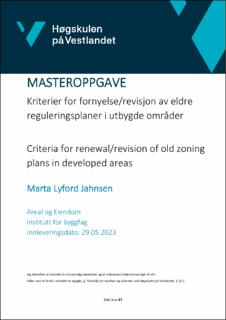| dc.contributor.author | Jahnsen, Marta Lyford | |
| dc.date.accessioned | 2023-06-27T06:19:21Z | |
| dc.date.available | 2023-06-27T06:19:21Z | |
| dc.date.issued | 2023 | |
| dc.identifier.uri | https://hdl.handle.net/11250/3073312 | |
| dc.description | Masteroppgave i areal og eiendom.
Fakultet for ingeniør- og naturvitskap/ Institutt for byggfag/ Høgskulen på Vestlandet, campus Bergen. | en_US |
| dc.description.abstract | Reguleringsplaner er viktige dokumenter kommuner bruker for å styre utviklingen av områder. Disse planene er gyldige til de endres, oppheves eller erstattes av nye planer, som betyr at reguleringsplaner kan være eldre enn du tror. Prosessen med å revidere/oppheve reguleringsplaner er også ressurskrevende og kostbare.
Masteroppgaven har utviklet en metode for å vurdere holdbarheten til reguleringsplaner, på bakgrunn av følgende hovedtema; lovregime, plandokumentets verdi og aktualitet. Metoden tar også opp kvaliteter som bør sikres ved en eventuell opphevelse/revisjon. Evalueringen av reguleringsplanen starter med kategorien lovregime, der en ser på om lovverket gir grunnlag for revisjon/oppheving. Det gjøres en grundig gjennomgang av planhistorien med fokus på prosess- og produktkrav. Reguleringsplaner preges av sin samtid, både av samfunnsmessige planoppgaver, men også av utrykket til loven. Lovregime 1924 introduserte det første kravet om kartframstilling. Videre diskuteres lovregime 1965 som regulere hele byggeprosessen, og hadde et større fokus på planleggingsprosessen. Lovregime 1985 satte fokus på flere faktorer enn arealbruken og bidro til en mer helhetlig planlegging.
Det neste temaet vurderer reguleringsplanens relevans og tar for seg kategorien plandokumentets verdi, hvor minstekravet til reguleringsplaner fremheves. Hvis minstekravet ikke oppfylles, taler det for revisjon/oppheving av planen. Deretter diskuteres aktualitet, hvor det vurderes om reguleringsplanen passer inn i samtiden. Nyere lovverk har forrang foran eldre reguleringsplaner, i tillegg kan planer som ikke samsvarer med faktisk bruk skape utfordringer. Eldre reguleringsplaner kan også generere dispensasjonsvedtak. Det siste temaet er kvaliteter som kan/bør videreføres ved oppheving/revisjon. Det er viktig å vurdere om eldre reguleringsplaner inneholder kvaliteter som taler for å beholde planen, eventuelt inneholder kvaliteter som bør sikres dersom planen vurderes opphevet.
Ved å fjerne eldre reguleringsplaner, vil byggesaksbehandlingen i mange tilfeller forenkles. Planregisteret vil i tillegg ryddes for utdaterte reguleringsplaner. For å belyse temaet brukes en casestudie, en eldre reguleringsplan fra Askøy kommune. På bakgrunn av funnene i Follese-planen, kan reguleringsplaner vedtatt under lovregime 1965 oppheves.
Det er ønskelig at funnene i masteroppgaven kan være en kilde til inspirasjon for andre i henhold til revisjon/oppheving av eldre reguleringsplaner. | en_US |
| dc.description.abstract | Zoning plans are important documents that municipalities use to manage the development of areas. These plans are valid until they are changed, repealed, or replaced by new plans, which means that zoning plans can be older than you might think. The process of revising/repealing zoning plans is also resource-intensive and costly.
The master's thesis has developed a method for assessing the sustainability of zoning plans based on the following main themes: legal framework, value of the planning document, and relevance. The method also addresses qualities that should be ensured in the event of repeal/revision. The evaluation of the zoning plan starts with the legal framework category, where the legislation is examined to determine if there is a basis for revision/repeal. A thorough review of the planning history is conducted, focusing on process and product requirements. Zoning plans are influenced by their contemporaneity, both by societal planning tasks and the expression of the law. The 1924 legal framework introduced the first requirement for map representation. Furthermore, the 1965 legal framework is discussed, which regulate the entire construction process and had a greater focus on the planning process. The 1985 legal framework emphasized factors beyond land use and contributed to a more holistic planning approach.
The next theme assesses the relevance of the zoning plan and addresses the category of the planning document's value, highlighting the minimum requirements for zoning plans. If the minimum requirements are not met, it supports revising/repealing the plan. Then, the issue of relevance is discussed, evaluating whether the zoning plan fits into the contemporary context. Newer legislation takes precedence over older zoning plans, and plans that do not align with actual use can create challenges. Older zoning plans can also lead to exemption decisions. The final theme covers qualities that can/should be maintained during repeal/revision. It is important to assess whether older zoning plans contain qualities that support retaining the plan or potentially contain qualities that should be ensured if the plan is considered for repeal.
By removing older zoning plans, the building permit process is often simplified. Additionally, the planning registry will be cleared of outdated zoning plans. To illustrate the topic, a case study of an older zoning plan from Askøy municipality is used. The findings conclude, based on the Follese plan, that plans developed under the 1965 legal framework can be repealed.
It is desirable that the findings in the master's thesis can serve as a source of inspiration for others regarding the revision/repeal of older zoning plans. | en_US |
| dc.language.iso | nob | en_US |
| dc.publisher | Høgskulen på Vestlandet | en_US |
| dc.rights | Navngivelse 4.0 Internasjonal | * |
| dc.rights.uri | http://creativecommons.org/licenses/by/4.0/deed.no | * |
| dc.title | Kriterier for fornyelse/revisjon av eldre reguleringsplaner i utbygde områder | en_US |
| dc.title.alternative | Criteria for renewal/revision of old zoning plans in developed areas | en_US |
| dc.type | Master thesis | en_US |
| dc.description.localcode | MOA300 | en_US |


